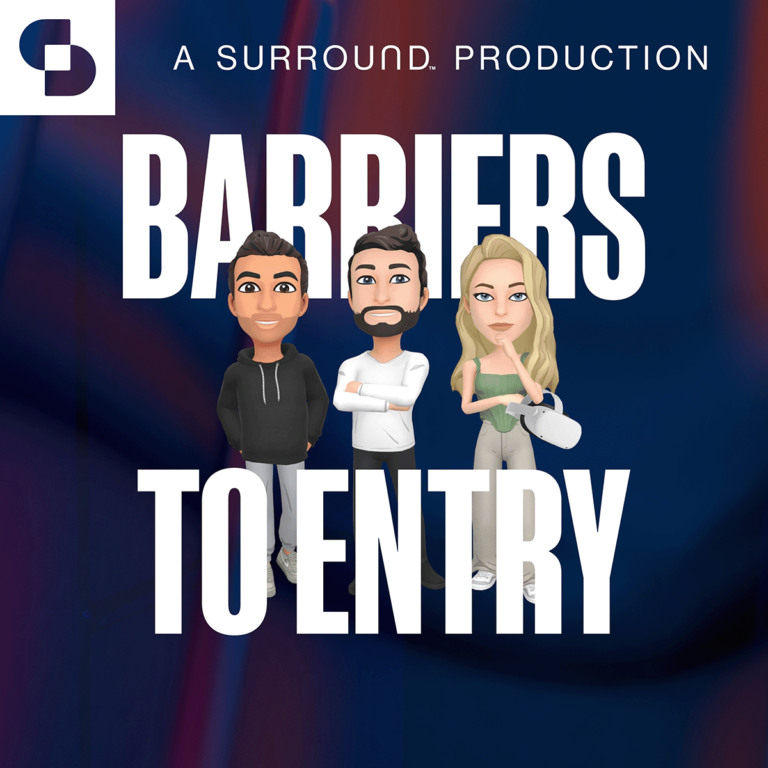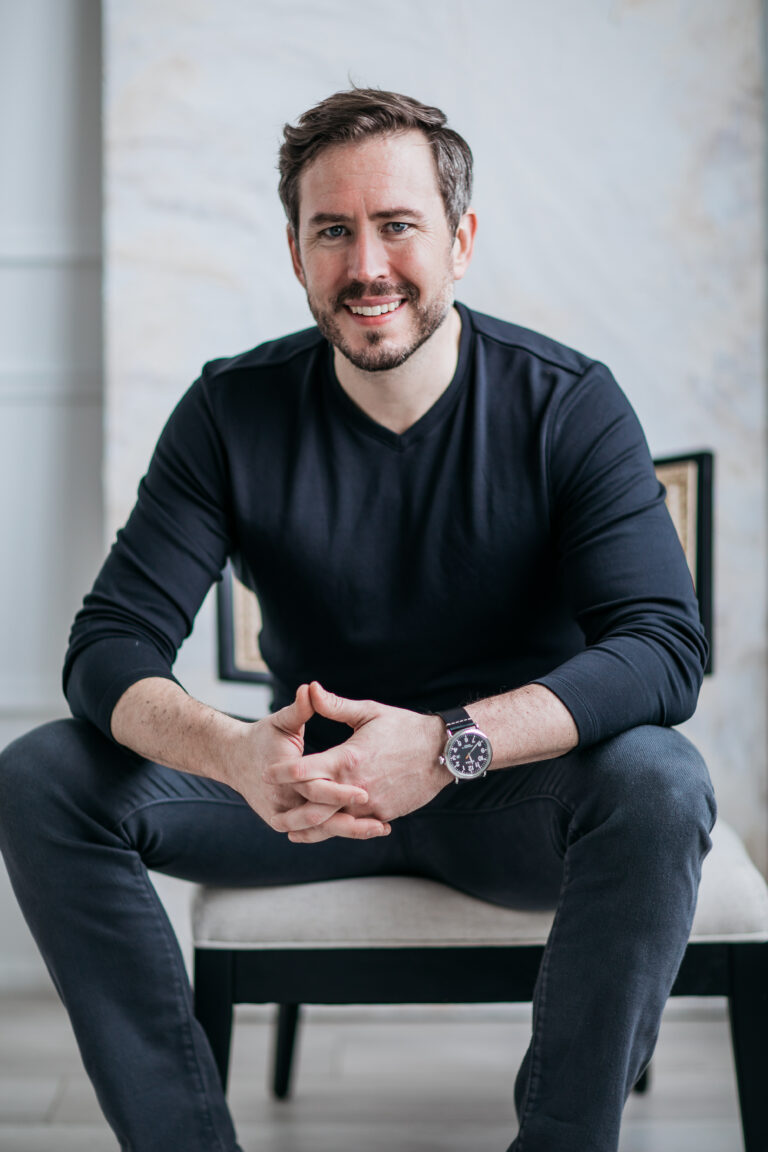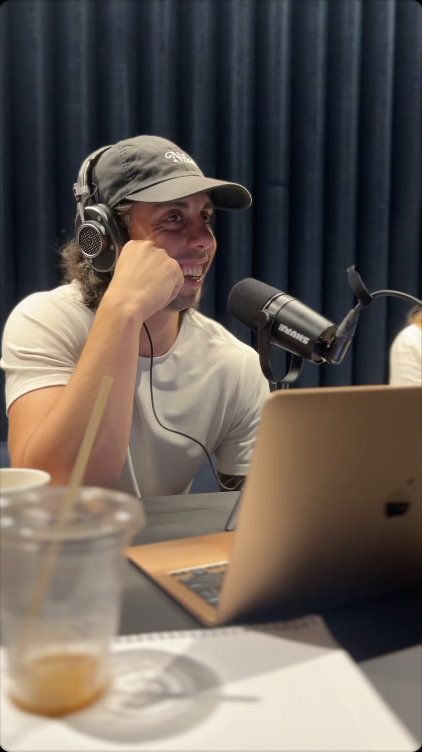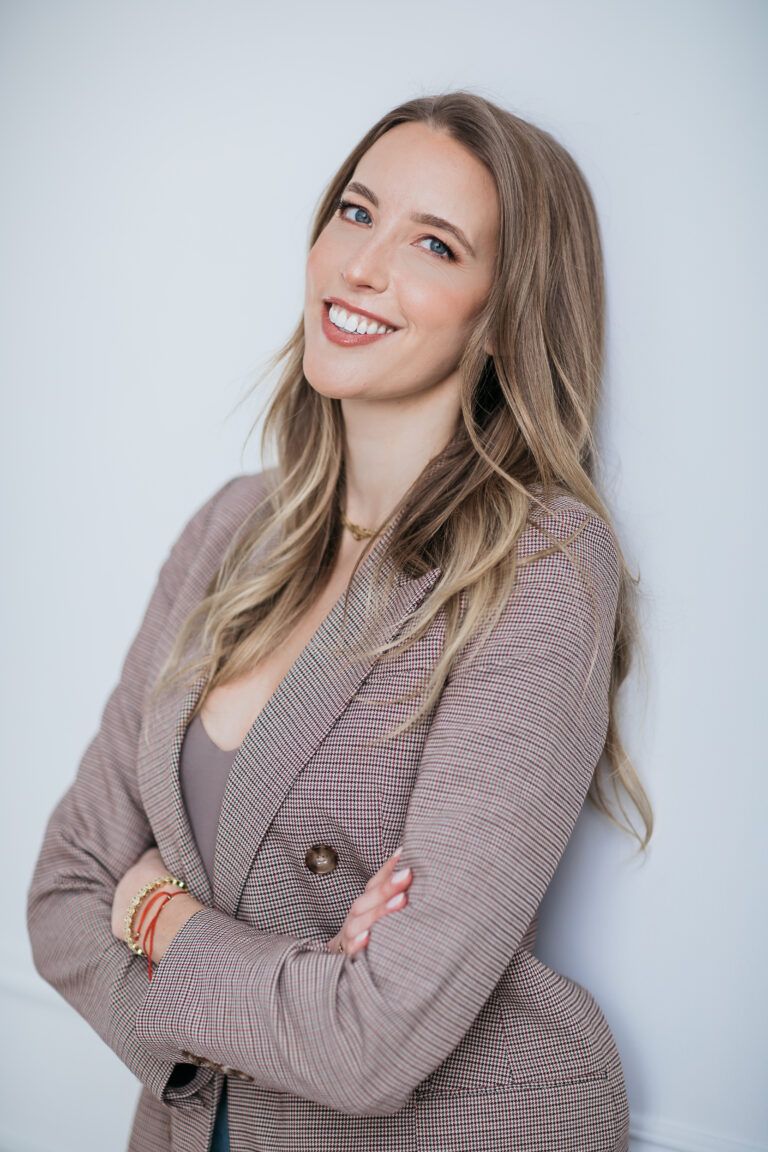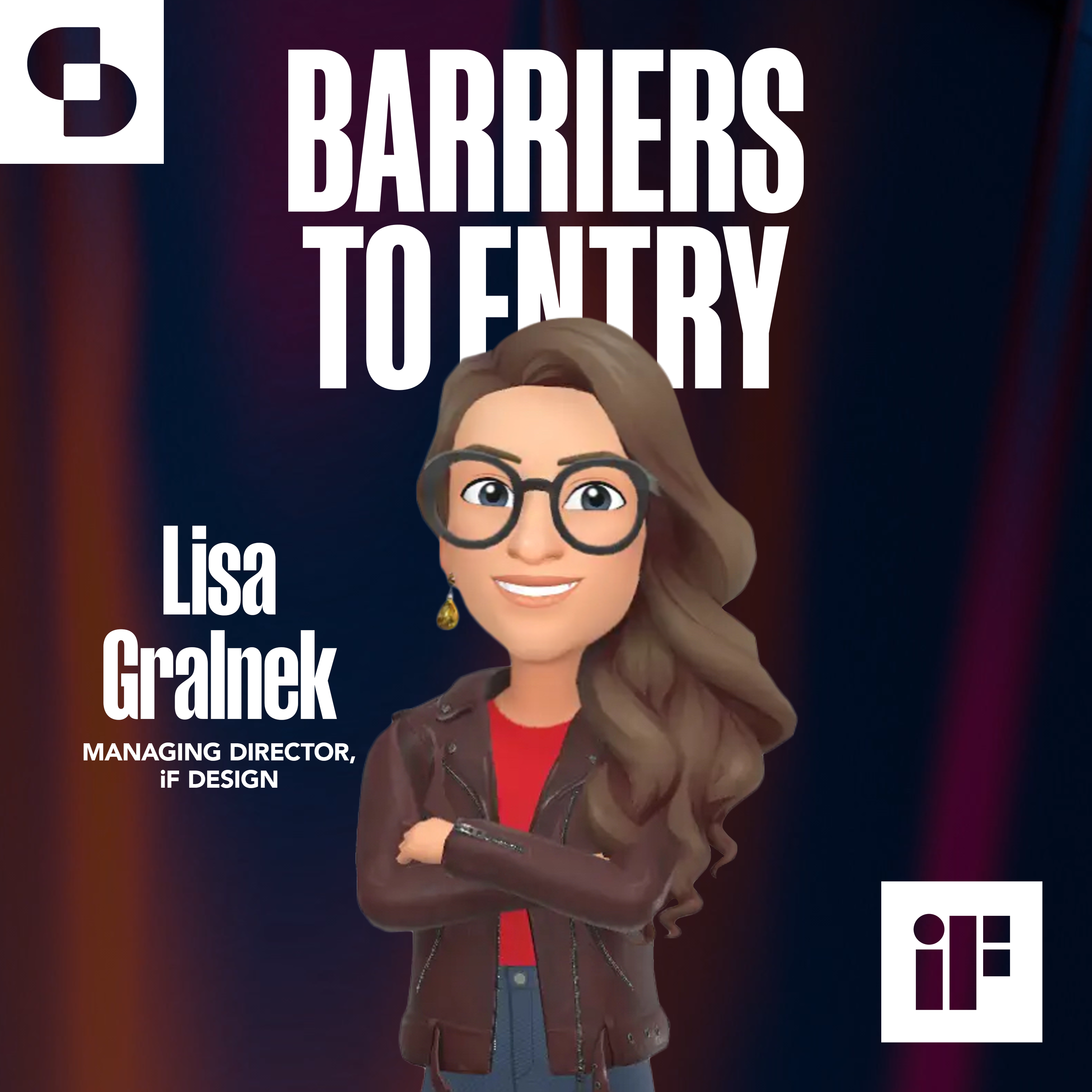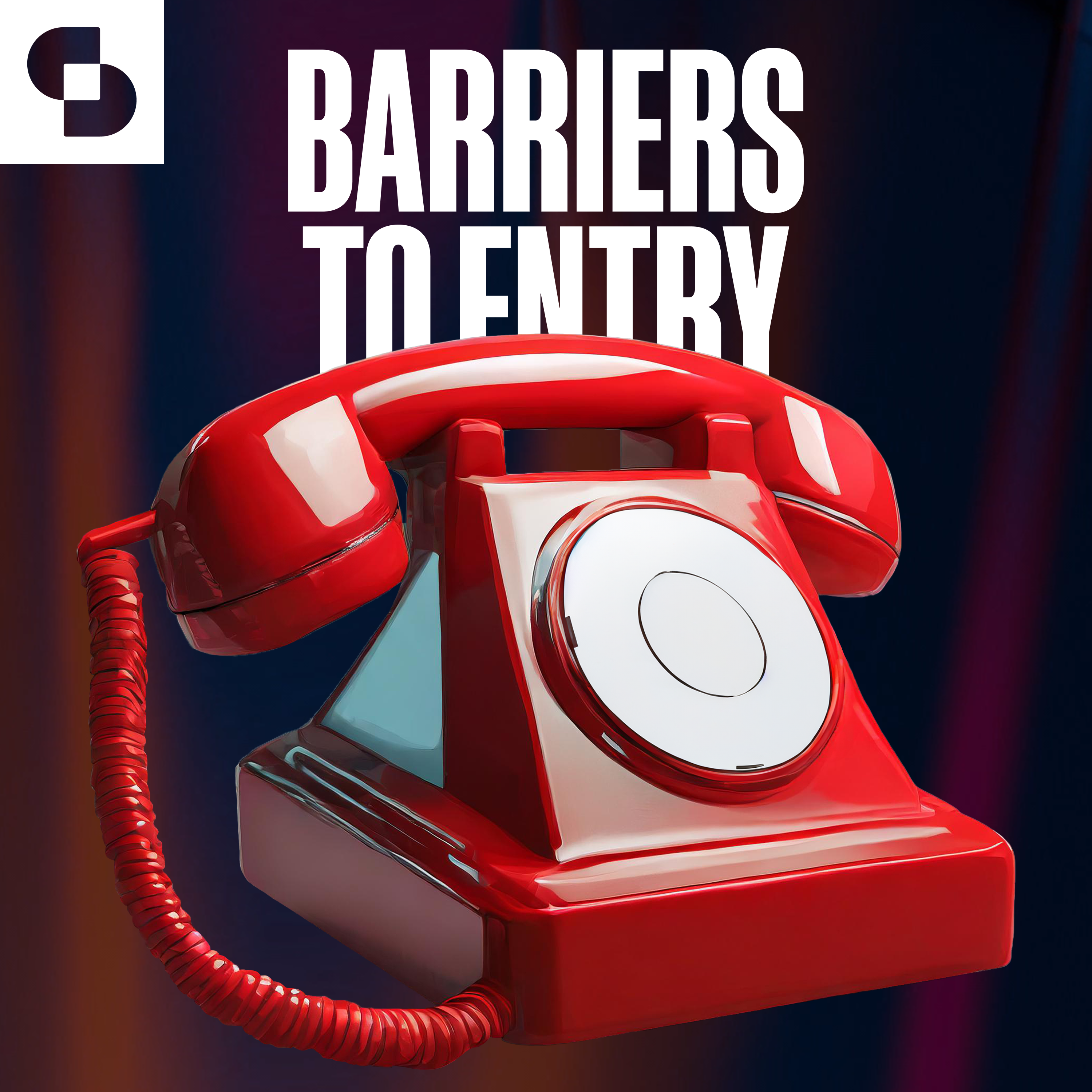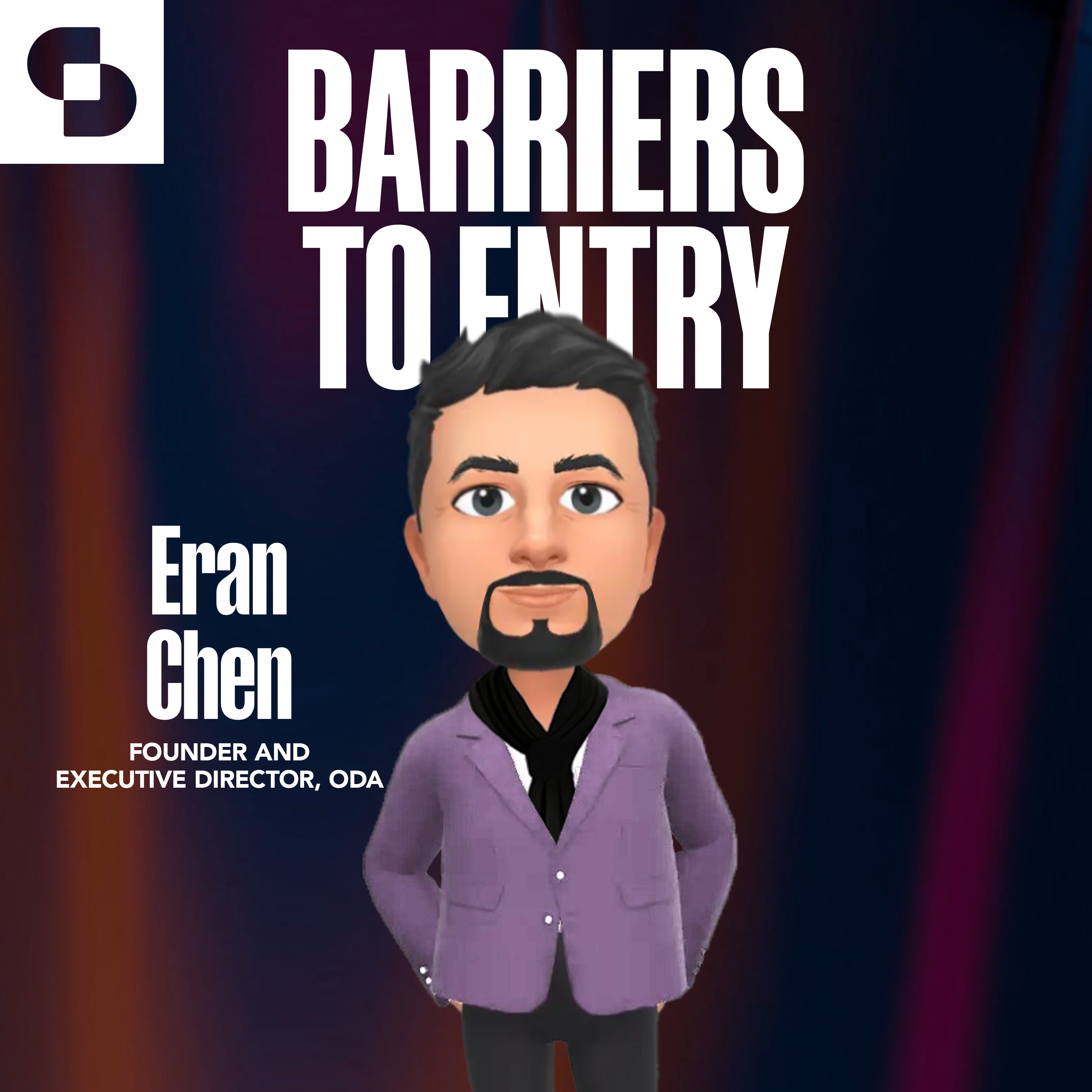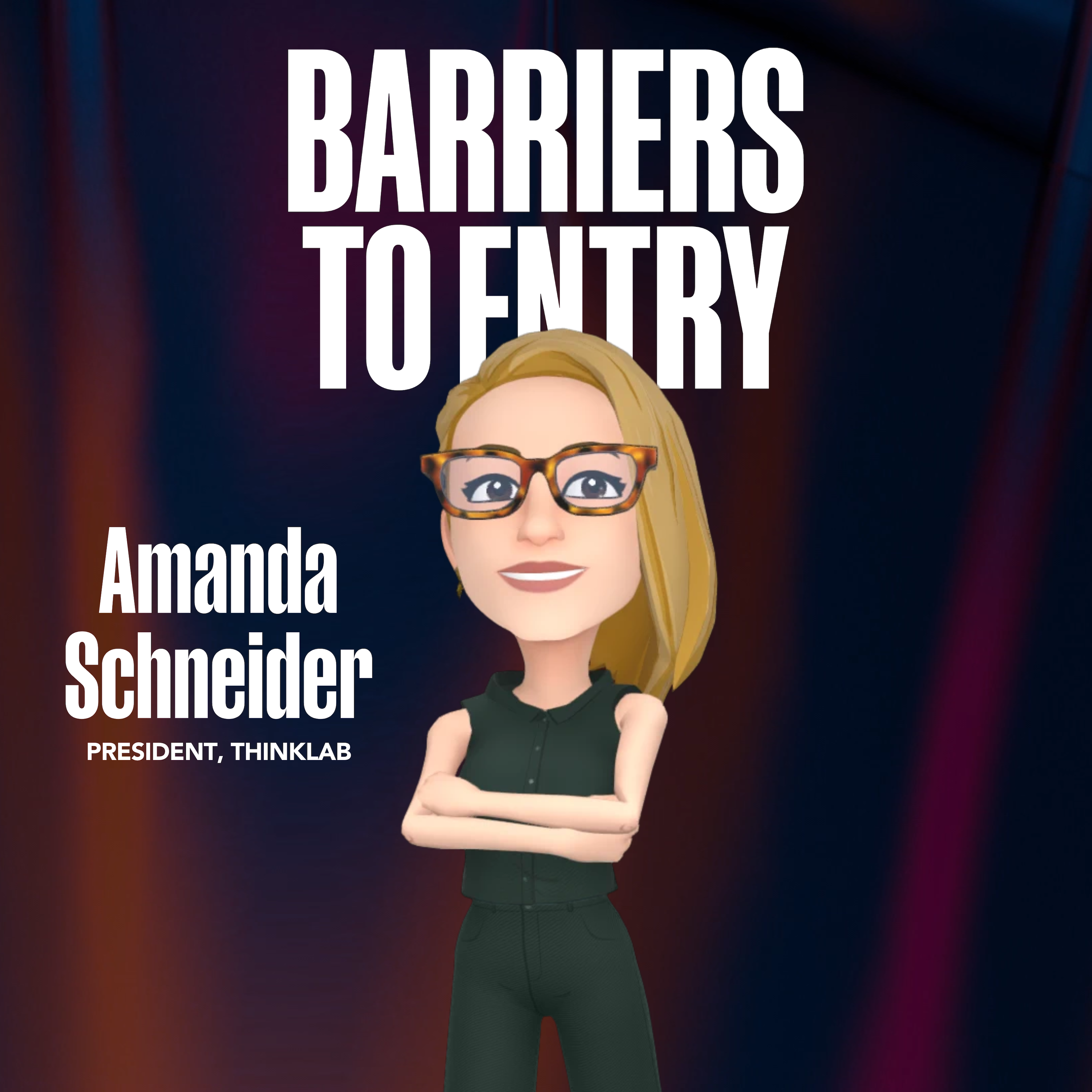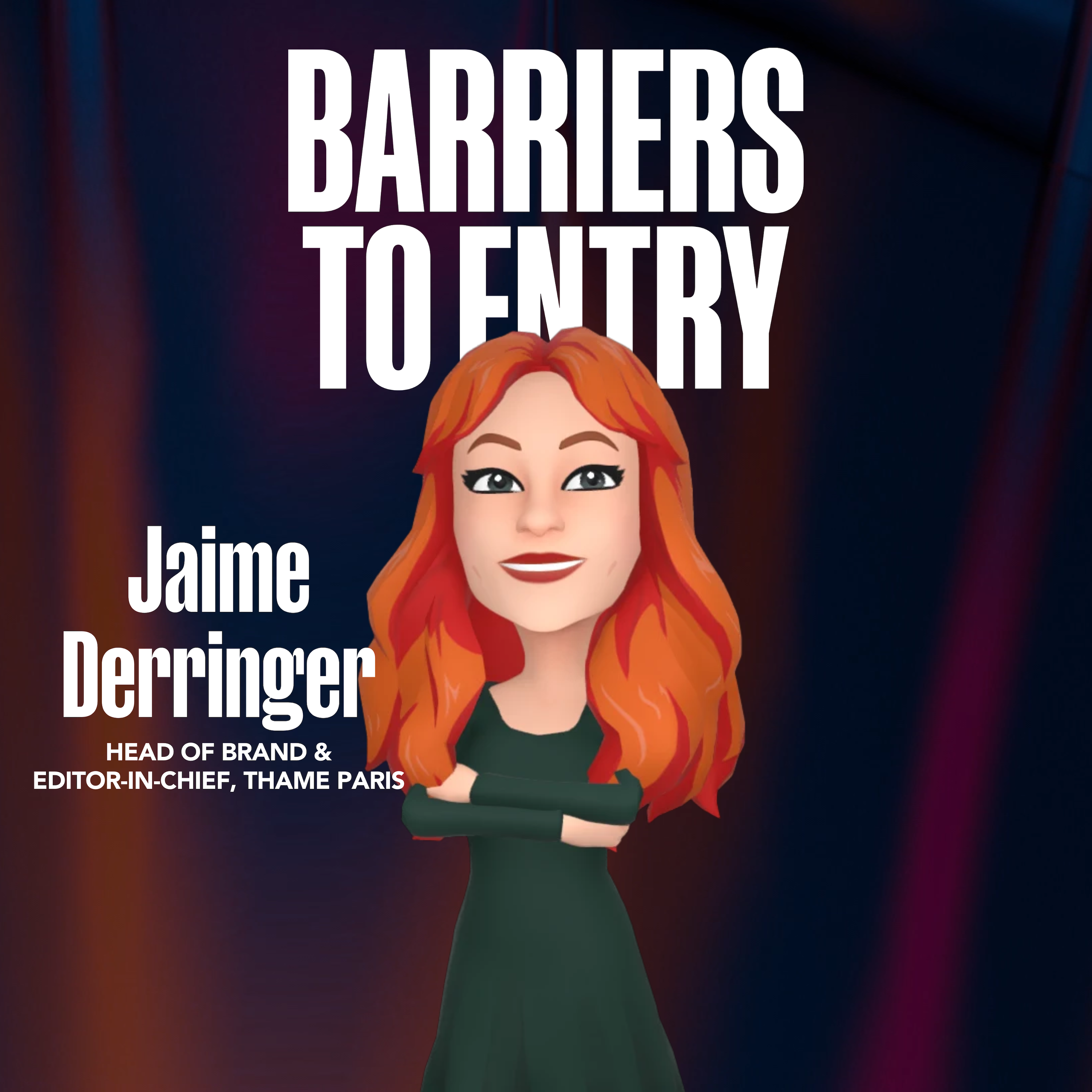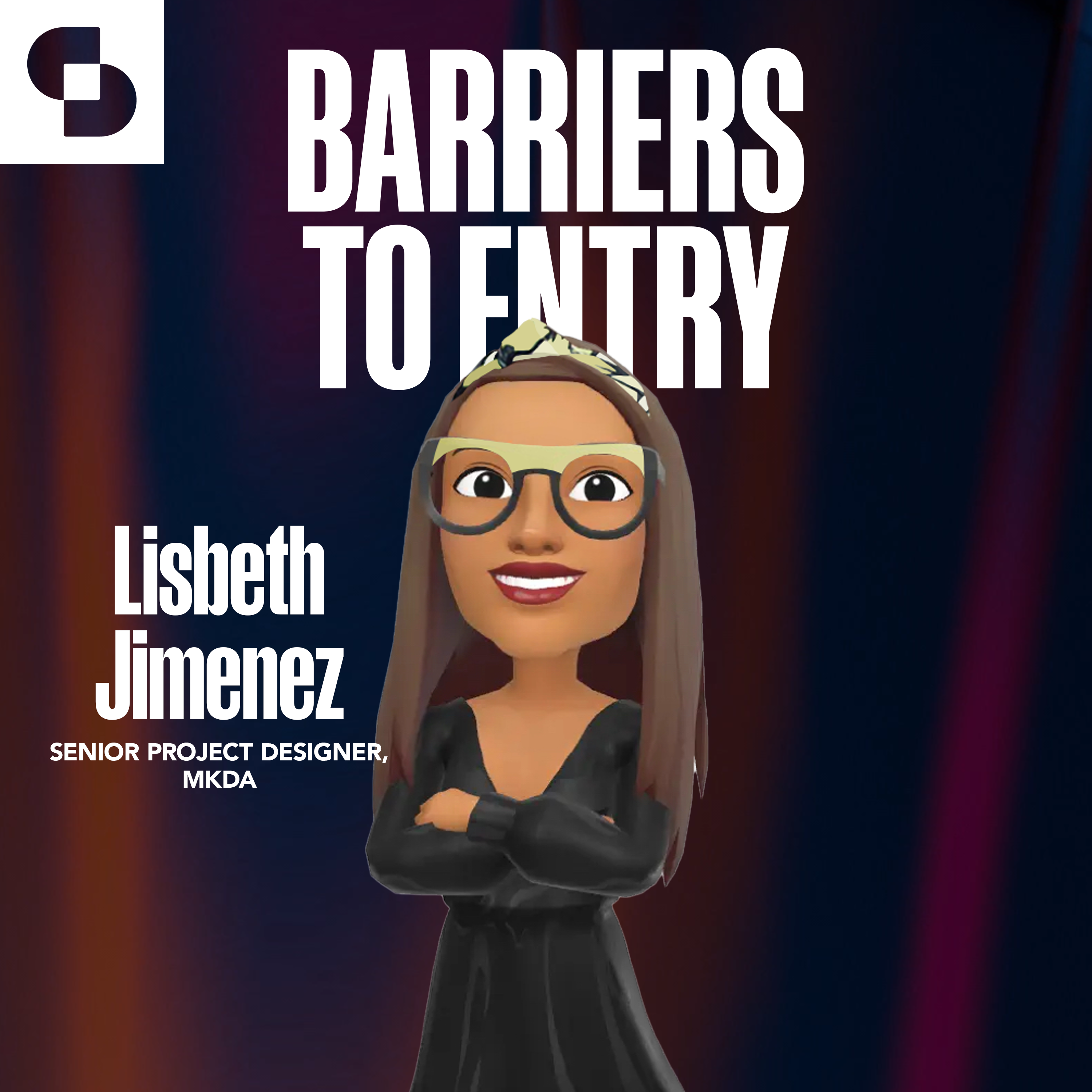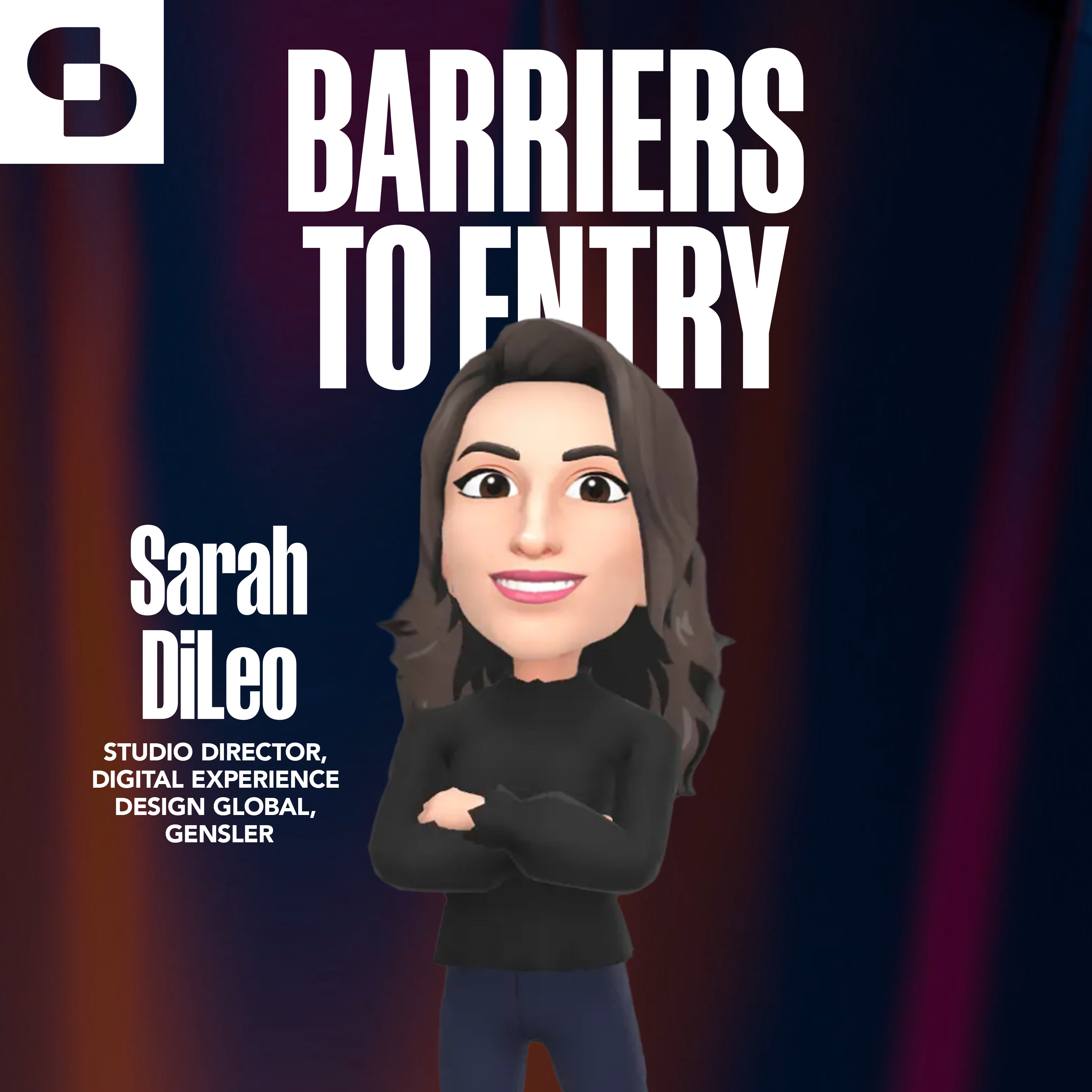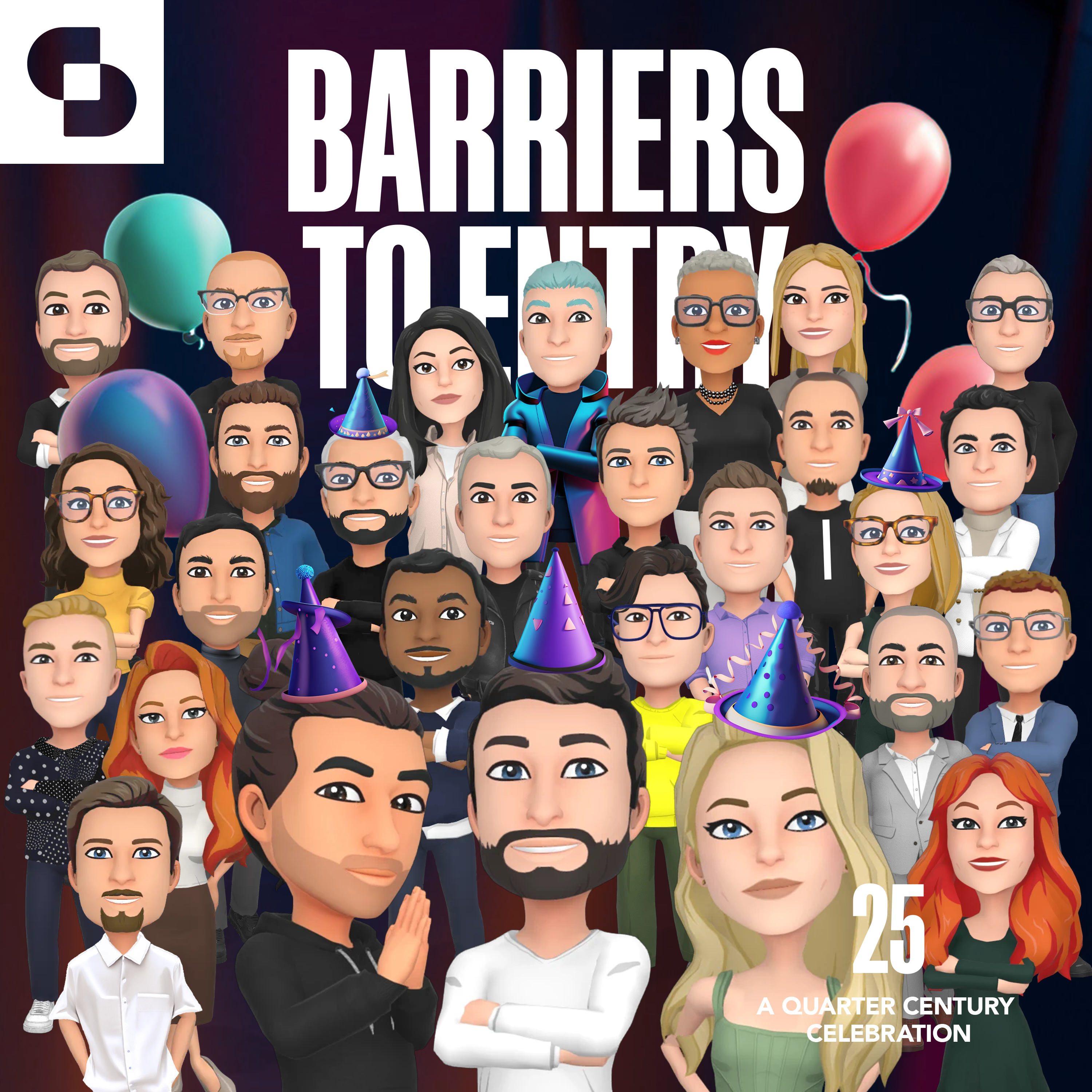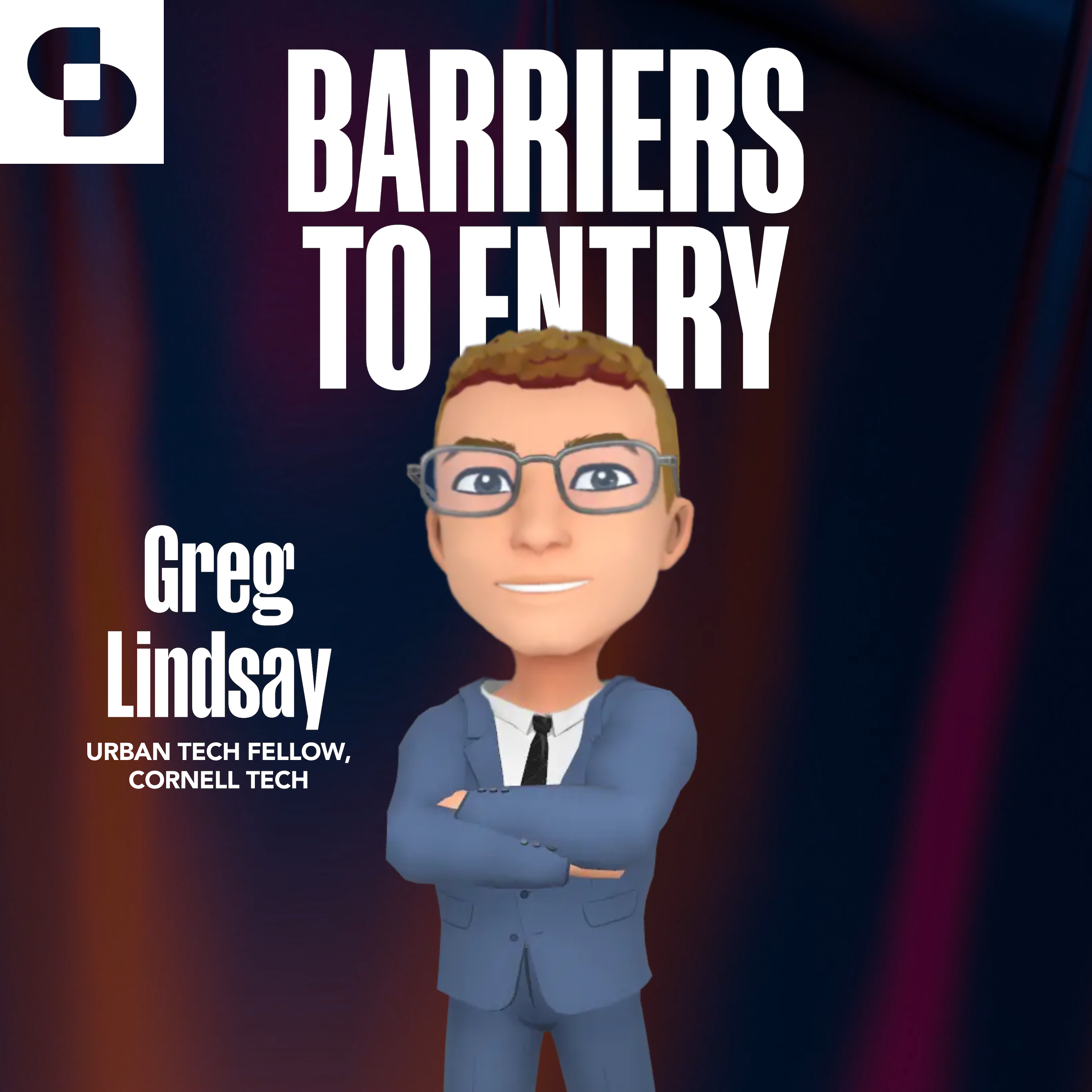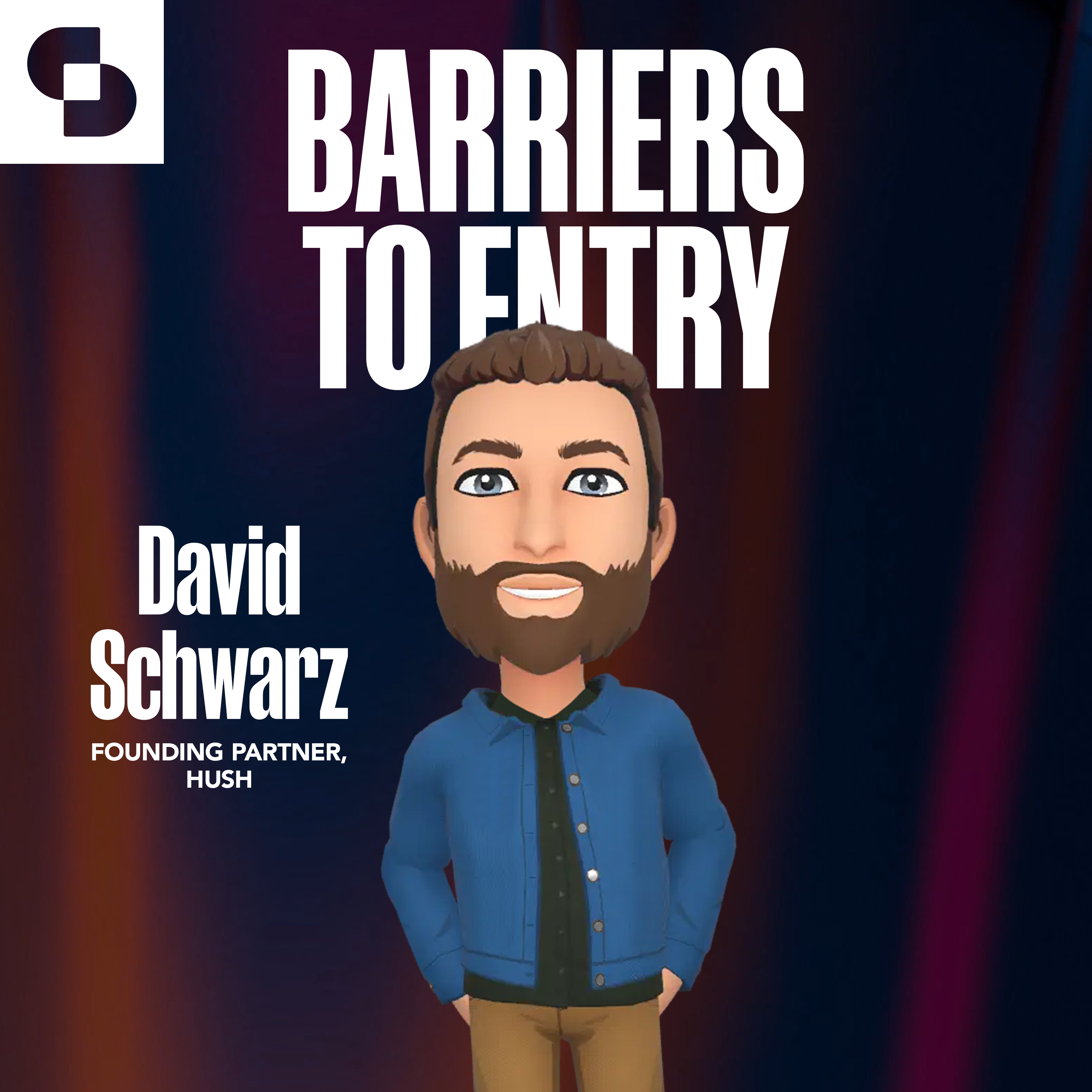Making magic at Maison et Objet
On the verge of the acclaimed French design show, Maison et Objet, the gang is joined by the fair’s 2024 Designer of the Year, Mathieu Lehanneur. Mathieu is regularly acclaimed for making ‘magic’ through his blending of design thinking with technology, psychology and beyond. While no rabbits are pulled from hats, the conversation ranges from the importance of standing behind your creative ideas, the fleeting impressiveness of technology and is highlighted by a deep dive into Mathieu’s work on the Olympic Torch for the upcoming Paris Games. It’s a special conversation you won’t want to miss.
Connect with our hosts on LinkedIn:
References and resources:
Maison et Objet Designer of the Year
Related and referred BTE Episodes:
Patti Carpenter – Trend Ambassador for Maison et Objet
Rodolpho Agrela – Founder & Design Director, RADS
Get in touch with us with your questions on emerging technology, innovation and more at [email protected] or drop us a voicemail at the BTE Hotline at 1-917-934-2812.
This episode of Barriers to Entry was produced by Rob Schulte.
This transcript was generated by an automated service. In some cases it may be incomplete or inaccurate due to inaudible passages or transcription errors.
Mathieu: [00:00:00] For me, there is no more magic in technology, whatever the complexity, whatever the smartness of technology, it’s never enough. Even the most advanced AI, you can show it to everyone’s, okay, what’s next? Okay. What’s next?
Bobby: Welcome to barriers to entry the podcast, where every episode we get into it with the leaders, the designers, the early adopters, and the influencers who are driving innovation in the architecture.
And design industry. It’s the metaverse, it’s AI, it’s blockchain. And it’s all happening here. I’m Bobby Bonet, an executive vice president at Sandow Design Group. And as always, I’m joined by Digby co founders Andrew Lane and Tessa Bain. And we’re back, back to back weeks of BTE. How exciting is that, Andrew?
Andrew: I’m exhausted already, Bobby. Um, you know, the back to back weeks. That’s taken a lot out of me. Tess, you were pretty well rested coming into the new year, but how are you, how are you holding up?
Bobby: Yeah, I was
Tessa: going to say, I actually feel really great. I feel like I’m like kicking off the new year, high energy, ready to go, total opposite.
Um, and super excited, you know, to be back on the pod in 2024.
Andrew: And our listeners don’t need to know that it was weeks between the two recordings, do
Bobby: they? Yes. That’ll be our little secret. Yeah, yeah. Two weeks though, two amazing guests. And before we get to this week’s guest, we do have an exciting and, um, funky little episode.
I would say coming up next week. It’s our hotline episode where we’ll be incorporating some user generated content into the episode. Um, so the theme for, um, two weeks from now, we’ll get back to our regularly scheduled programming. We’ll be, we’ll be bringing in predictions from past barriers to entry guests for what they’re looking ahead or expecting to happen in 2024 at that intersection of design.
And innovation. So Andrew test and I have been listening to the voicemails. I love
Andrew: having an answering machine, by the
way,
Bobby: Bobby, I know. Isn’t it
Andrew: [00:02:00] nice? It’s pretty fantastic. I’m excited for the answering machine to blow up to the point where people will call in and get that message that says this mailbox is full and get that frustration really happening for them.
I think that’s going to be an exciting moment. That’s
Bobby: always our goal is to frustrate the listeners. If you do want to call the hotline, uh, the number easy to remember, by the way, 917 934 2812. 917 934 2812. So call in, leave us a voicemail on the BTE hotline, and you might be featured on a future episode of Barriers to Entry.
Um, should we get into this week though, Andrew and Tess? Can’t wait. Let’s do it. So, um, Maison Objet is just around the corner, and so we’re lucky today to be joined on Barriers to Entry by Matthew Lenore. Matthew is a renaissance man pushing the limits of design through magical experimentation. I think it’s fair to classify Matthew’s work into three formats.
Pieces, places, and solutions. Some of those solutions include cell bag, a water transportation pag, once upon a dream, a smart sleep installation, and tomorrow is another day, the weather experience. Notably, Matthew is also the designer of the 2024 Paris Olympics torch and Maison Objet’s 2024 designer of the year.
Let’s get into all of this and more. Welcome to the show, Matthew. Thanks so much for joining us today.
Mathieu: Hi,
thank you very much.
Andrew: It’s great to have you.
Bobby: And when we read about you, Matthew, and and I mentioned it, you know, right at the top of the intro, the word magic always pops up. Um, and and I’d love to know.
And I think Andrew and Tess would love to know as well. How do you harness the idea of magic in your creative style? And why do we hear the word magic always, you know, juxtapose alongside your name?
Mathieu: Actually, for me, um, playing with magic, it’s always a way to combine different approach. I mean, working very closely with Magicians.
technology with very specific techniques with science sometimes. But the, [00:04:00] the, the purpose of that is not to make a tribute to technology or even tribute to craftsmanship, but to always trying to create a relationship, a weird sometimes relationship between the user, um, and the things because My job, it’s building things, but a thing is just a thing.
So the idea, it’s trying to create a kind of energy between a thing and a human being by kind of invisible vibration that I call it magic. Is
Bobby: there a point in your design process when you’re building something and, you know, that, that magical spark happens or do you set out to create magic? You know, is it something that just happens by accident and you’ve figured out that way, like a magician, to make that magic just happen intrinsically during your design process?
Or do you know how to create it? I’m wondering if there’s like a little bit of that kind of magical energy that just happens to pop up in a Mathieu Lenor
Mathieu: project. It’s never happened by accident. It’s, it’s always start with a kind of scenario in mind by something I want to create, um, thanks to, to, thanks to the piece.
and trying to build something not sometimes new, but sometimes that never been seen before, just to give you an example. Um, one day I was just in front of a sideboard and on this sideboard as a very traditional sideboard, there was a kind of delicate and beautiful vase and glass vase on top of it. And, um, and I was thinking, okay, we are doing the same since.
decades and even centuries. And could we try to, to, to turn it upside down? And can we imagine that the vase, the delicate things that appear to be fragile might be the things able to support, able to carry on the heavy things as a sideboard. So it starts in that way. And, [00:06:00] um, and from that, thanks to the techniques I learned, thanks to the craftsmen I work with, uh, we have been able to put a massive weight of marble just displayed on that appears like fragile and delicate blown glass vessels.
But of course, to, to make it happen, you need to clearly know the materials who need to clean all the processes. And, um, and it’s not the question of, because I’m not working as. It’s only image or 3D renderings, but the idea is to, at the end, put it into reality. So and the magic appear in the reality. So to make that the idea, it’s from this very simple idea.
To met a lot of tests, to met a lot of crash tests sometimes and, um, and to being able to step by step to erase, to make disappear any technical element, just to keep the initial and, um, very first ID and initial
Andrew: intuition. I love The intro about magic and how much you’ve talked about tech and it really makes me think there’s there’s a famous science fiction, um, writer, Arthur C.
Clarke, who, uh, one of his laws was that any sufficiently advanced technology is basically indistinguishable from magic. And part of your work, some of the people who you collaborate with include scientists and engineers, as well as artisans. How is that dynamic at play in your design process? You’ve mentioned technology a couple of times already.
How are you thinking about all of those intersections in order to achieve all that you’ve just described?
Mathieu: The main thing it’s for me before contacting specialists, scientists, or wherever the, the. the skills. It’s first of all, to take time to learn the language. Um, when, when you need to push the door of someone of any specialist, you need from your side to spend times to, [00:08:00] to learn a lot about his skills, his domain.
And, um, and After that, to never forget your initial idea, your initial intuition, because when you start doing the process, sometimes you, you forget what you was looking for. So it’s super important for me to, to always keep next to my. Computer the initial sketch to never forget. So whatever the time that a project will take to always go back to the initial idea, sometimes it may appear as naive, but for me, it’s always the essence of the idea remain is the initial sketch.
So whatever the challenge we have to go through, whatever the problem we have to solve, um, the idea, it’s never forget. And sometimes during a project you want to make something And sometimes it takes a decade, you know, because, um, just to give you an example, since very long time, I wanted to create a way to recreate the, the perfect, um, liquid effect, um, into the marble, uh, to, to recreate what’s the perception you get in front of the ocean or in front of the sea.
I mean, just by feeling that Okay, you are at the right place at the right moment and in front of the sea and the ocean. Actually, you never think, need to think, you never need to talk. You’re just enjoying the fact that, okay, I am in front of something bigger than me. And, um, 10, maybe 15 years ago, I wanted to find the best way to recreate this liquid effect.
For that, there is many ways to do it. Uh, you can ask the best sculptors to recreate and to mimic actually the relief of the sea. Um, you can take some high resolution photos and turn it into a kind of 3D relief in real. But It was not the good way. So sometimes you need to wait a lot and waiting for the [00:10:00] right process, waiting for the right technology to turn the initial ID into reality.
So for me, just for this idea, it took us probably 15 years. Yeah.
Tessa: I mean, your portfolio is, um, unbelievably fascinating. I think you’ve referenced already. You’re happy to be here. Console, which is. Probably one of my early exposures to your works and one of my favorites, um, as well as, um, I believe you’re just, we’re discussing ocean memories.
Also another favorite, uh, piece, which I think is so beautiful. Um, we are going to get into what’s coming up for you in 2024, but before we do that, can you take us through your favorite solution that you’ve created over your career and then the role that technology played in that design process?
Mathieu: Maybe if I, if I had to select one, um, I would probably choose a project, um, that Bobby mentioned in the introduction that called Tomorrow is Another Day.
That is what you mentioned as a weather experience. And um, and what I love in this project, first of all, it’s the commission itself and the commission came from the head of an hospital in Paris. And, um, and he came to, to see me and ask me, I wanted you, Mathieu, to design something, might be a design piece, an art piece, whatever, um, for our palliative care departments.
It means I would like you, Mathieu, to design actually what’s going to be the, the, the last. piece, the last object that people will see in their life. Wow. And, um, and for that, I decide to, to create an install to every single room of the departments, a kind of, uh, um, circular You blow a circular window, actually, um, with LED screen inside.
And this piece will be able to display continuously what will be the sky of tomorrow. My idea was to make the people who are going to leave the [00:12:00] last days, maybe weeks of the life to always see what tomorrow will be. To always, whatever, if they will be alive tomorrow, they will always get this kind of step forward to what the sky will be.
And this, for example, I need to use technology for that, of course, because it has a kind of LED screen inside. But more than that, I didn’t want to make people in those rooms being in front of a kind of video loop, you know? Initially, I was expecting, okay, we’re going to broadcast. probably 30 different skies, rainy, cloudy, stormy, sunny.
Um, but in that way, since people will stay all day long in the room, uh, they will probably recognize the cloud that says from the morning to the afternoon. So actually they would. not open them up to the tomorrow, but probably they make feel that, okay, I am into the, yeah, mostly actually. So for that, we, we decide to change our ways and, um, and we develop a very complex program, able to gather all the information coming from the biggest weather forecast worldwide.
And being able to get all the parameters information about speed, wind, about, uh, brightness of the sky, about density of the cloud, about all those time of parameters and in creating an animation in order to be sure that the cloud that’s going to be seen the morning you will never see it again. Just like in the real sky.
So, in this project, for example, I needed to work with various specialists, programmers, different type of skills, but what I love, it’s at the end, the patients never think about the behind the scene of that, the technological behind the scene, they’re just in front of the kind of artificial window. And, um, and from that, we add a, um, another feature.
It means that they every single patient can choose [00:14:00] his own sky, right? So if they’re coming from, um, Africa, America, Asia, Tokyo, Los Angeles, Bamako. Um, they can ask to the staff, can you connect me with, um, with Paris? Can you connect me with, uh, San Diego? Because my, my relative live there and I want to be connected with them, thanks to the sky.
Andrew: That’s definitely the magic. Yeah, no kidding that it’s indistinguishable, right? That people just are in the experience, but that’s incredible the way that you’ve gone through that rigor.
Bobby: What was, what was the reaction you got to that, Matthew? It
Mathieu: was, um, super moving feedbacks, um, coming from the patients themselves, coming from the relatives, and from the relatives, it was very interesting because as you may imagine, when you open the door of your father, your mother, your son, who’s going to probably pass away in the next coming days, it’s super difficult to find a topic of discussion, because The human beings always talk about the future.
We are continuously talking about the future. Tonight, tomorrow, the next weekend, next holidays, when I’ll be retired. And, um, with the people was no future by definition, it’s super difficult to find the topic. And just by this simple piece, just by playing on the idea of the weather, actually it was a super good starting point for the conversation.
Because you open the door and you say, Oh, look at the sky in Bamako. Uh, not super sunny, you know, and okay, you go back to the reality, you go back to the, to the daily life. So it was the first feedback. And, uh, another second, super, uh, moving feedback I received was a mother coming from, uh, um, Africa, North Africa, as I remember.
Um, and she was based in Paris. So in this department and, um, And she decided to change the sky every single day or a couple of [00:16:00] days. One day she said, Oh, I would like to be connected with Tokyo. And the day after, I would like to be connected with Washington and LA and so on. And, uh, and of course the staff of the hospital said, of course, no problem.
They arrive with their iPad and select the sky requested. But after few days, one of them asked to the woman, but why do you want to change continuously the sky? You, you can do, of course, but why? And the woman explained that, okay, because me, my son is a pilot, so thanks to your specific and magic windows, I can always text him what will be the weather when it gonna land.
So thanks to this, actually, I can remain a mother to the very end of my life. Wow. I love that. So love the fact that, okay, you use technology. Okay. You use some super complex program and complex softwares, but at the end, and for me, this is the only propose of my job. It’s to make this woman feeling okay. I will remain a mother to the last second of my life.
Bobby: I do have one really quick question. Um, just a quick follow up on that. So It sounded like Matthew, when you were commissioned or asked to work on on this project, that maybe the hospital was probably thinking much smaller than what you ultimately developed as a solution. How often does that happen where, whether it’s a hospital, whether it’s a spirits company, whoever it may be, somebody comes to you and says, I’d like for you to design or develop or build something and you come back with something that just, you know, explodes outside of the box.
the barriers of what they were imagining. Is that pretty typical for you where they’re expecting maybe an object and you come back with something that’s just, I’m going to use the word one more time and I won’t use it anymore, but magical? No,
Mathieu: it’s not. It’s not. Of course, it’s not very typical, but, um, in my career so far, I received very specific commission like this.
It might be a [00:18:00] priest. Uh, it might be this head of hospital. It might be a surgeon for another topic. The first thing I discovered thanks to this commission and thanks to those guys, it was actually Designers themselves sometimes are too much traditional, conservative. And, um, and for me, it’s a big surprise what to discover that the rest of the world, I mean, outside of our creative field, are sometime more open than we are.
And, um, as you may imagine, probably the head of the hospital, probably the, the priest or the surgeon do not read or consult, uh, design blogs. But they have understood that a designer is probably one of the best persons to, to, um, to propose some new potential relationship, um, in their context.
Tessa: So you were commissioned by Paris 2024 to design the Olympic torch. Give us a little bit of background on how you approached that project. And we know that that also includes the Games Cauldron. And I think that we’d be really interested to know how was your approach towards designing those pieces different from those who have had that same honor in the
Mathieu: past?
The first thing was for me to avoid to spend too much time, um, investigating the past of the Olympic torch and to arrive in this field. As most virgin as I can get. So fully blank, like a blank page and not to be too much informed about the past. The second thing is for me, the most relevant clients and the most interesting commission.
Most of the time do not arrive as with a [00:20:00] very large brief, you know, no board, no Inspiration. I should be. I should use no any clues about what they are expecting what I was explaining with with head of the hospital department. It was arrived is no brief, right? There was no brief and with Paris 2024. Of course, the brief was The torch and the cauldrons, nothing else.
They explained to me that we, of course, we have some ideas, some intuitions, they may have some inspiration, but they force themselves to do not put them into the brief. And the brief was actually The flame needs to be, uh, needs to remain up, um, during all the relay. Um, the weight needs to be quite light to be able to make any relay bearers able to carry the torch.
Um, the size needs to be between 60 and 70 centimeters just to be visible by the public and to avoid to burn the heirs of the religion That’s all that’s all so they told me they remain open to answer any question to provide any information But they accept that if they choose One designer or one creative people, they trust him or they trust her to, to do the job.
From that, they decide to open a competition and, uh, it was, uh, uh, with a close competition. I mean, they select, um, they pre select 12 designers, French designers, and, um, giving this very light brief, as I explained. And, um, And from that we, we, we had, uh, one month to propose a torch and a cauldron as I did.
And for any project, I always propose one thing, I never propose different options. Mm-hmm. Right. I never understood this, [00:22:00] um, to, for the creative people to propose several options for me. Because for me, just like a doctor, you know, a doctor, if you’re going to see the doctor, because you have pain, I never saw any doctor who said, okay, you can take those pills, the red ones, but I do have this syrup, a red, yellow, that is good.
Also. No, it’s impossible. Of course, in the creative process, we go through many different ideas, options, inspiration, but I always propose one thing. This is the only one I strongly believe in. So I propose the idea for the torch, for the cauldron, and, um, maybe two weeks after I received a phone call, told me, okay, we select you, Mathieu.
That’s so cool.
Bobby: The cauldron will be unveiled this summer. Is that true?
Mathieu: Yes, probably. Um, traditionally and historically, the cauldron is the last chapter of the opening ceremony. Mm-Hmm. , um, the, the opening ceremony in Paris will be on the two, on the two banks of Theen River.
Andrew: They’re not in the, in a stadium for the opening ceremony, not in a
Mathieu: stadium for the very first time.
That’s very cool. It’s gonna be, it’s gonna be amazing. Just to give you an example, as you know, traditionally, all the countries and teams and delegation arrives in the stadium with the flag. It’s beautiful, but quite boring, you know? Um, so here, all the countries will arrive by boat. That’s so cool. One boat, one boat per country, one boat per delegation.
Andrew: Some of the boats will be quite small. I hope that that’s going to be Of course,
Mathieu: of course, you’re right. And it’s going to be beautiful and probably sometimes funny, um, because probably the U. S. boat’s going to be a huge
Andrew: one. They’ll make sure of that, yes.
Mathieu: Of course. And probably from tiny countries with very few athletes, [00:24:00] it’s going to be, I don’t know, maybe
Andrew: just A raft or like a, yeah, a canoe or
Bobby: who knows, wow,
Mathieu: just paddling alone.
And even this probably going to be super, super, um, super beautiful and moving. And it’s going to be full of audience because, because in a stadium, it’s only VIPs. Many of them, thousands of them, of course. But here in the, around the, the, the sand river, it’s, they are waiting about, uh, uh, six. 000 people, you know, um, yes, it’s going to be
Andrew: made.
This is a good promo to watch this opening ceremony. This sounds incredible.
Mathieu: Yes. You have to. Oh my gosh. Yeah. And, um, and the last really beer, uh, that is. always a kind of iconic people, uh, coming from sports field or not. Um, but usually yes. And, uh, we’ll arrive and to, uh, to light up the cauldrons with the last torch.
That’s so
Andrew: amazing. Very cool. Tess and I are Canadian. Um, and I, there’s nothing that gets me feeling more Canadian than the Olympics, I have to say. So, you know, What did it feel for you, or did you have a particular reaction to getting that phone call and being chosen? Cause like, I couldn’t imagine my country actually calling me to do anything.
Um, but,
Bobby: you know, to create
Andrew: the Olympic torch. Like, that’s incredible. Um, so, you know, what was, what was that day like? What was that feeling like?
Mathieu: You know, um. I’ve been more than happy, as you may imagine, but probably for 30 seconds to one minute maximum and, um, and just after that, the, um, the countdown starts to, uh, to go on because it was in at the end of January.[00:26:00]
2023. And, um, and the torch has been revealed in July 2023. So going from the 3d rendering, um, that was at this stage during the competition, I was actually not sure that it might be possible to be made. Um, it possible to include all the technical elements we need to include into the torch because it’s a very, very complex object, the torch.
It appears simple, but it’s super complex inside in order to get a perfect flame at the right color, at the right. size and whatever the weather condition being able to always remain beautiful. So, um, the timeframe was super short. So the happiness moment was super, yeah, super, super short. And after that, it was a long process to met a lot of, uh, a lot of tests, a lot of, uh, We brought some big fans, for example, you know, you know, workshop to test the flame in different condition because the flame needs to remain beautiful and visible, even in the storm, you know, so, um, and frankly, before, before the, the, the reveal of the torch, and, uh, I just very recently, um, took in mind that, wow, I’ve designed the torch.
I’ve designed the Olympic torches. Wow. Yeah. Super cool. But yeah. And, um, and probably because I discover just after the torch I’ve been revealed that. The torch and whatever the design, um, the torch itself for this edition, but even of course in the past is a magic object. And as soon as you show it to any people, um, interest by sport or not, people are just like in front of kind of, yeah, something super, um, super rare, super exclusive, super magic.[00:28:00]
I do remember I get some interviews about the torch and, uh, at the end of the interviews, open my bags and, and taking the torch out and people around was, wow, this is the Olympic torch. You know, for me, it was something, okay, yes, I’m working on this for, for six months. I know every single millimeter, cruise details of it.
Okay. It’s actually one more object. Right. But I keep in mind that no, it’s not. It’s not, it’s very, something very, very special. And maybe
Andrew: it’ll be when you’re in your little VIP boat on the Seine and you’re seeing it, you’re seeing it brought to the cauldron. That might be another incredible moment, but, um, congratulations.
And it’s a beautiful design. We’ll be sure to share, um, the, there’s a great little website with the story of it, um, that the Olympics committee has put together. So we’ll be sure to share that in the show notes from this episode. Um,
Bobby: that’s incredible. So. 2024, we’ve got Paris 2024, which is obviously a monumental story for you, Matthew.
You’re also rolling into 2024, as we mentioned earlier, as Maison Objet’s 2024 Designer of the Year. And as part of that, next week, you’re unveiling Autonomy. And just as Andrew shared with The Torch, we’ll share some photos of Autonomy in the show notes. But I’d love for you to share what your goal was with Autonomy, and what’s the story you hope it brings forward to those who experience it during Maison Objet.
You
Mathieu: know, for, for Maison Objet Designer of the Year, Usually it’s you are supposed as a designer of the year to make a kind of retrospective exhibition of your work. And, um, for me, it’s not super interesting to, to do so. Um, because I do make some exhibition in. In museums, but also in in my factory and in the apartment in New York, as you mentioned, so getting just a kind of retrospective exhibition was not super interesting for me.
So I wanted to create. this opportunity as a project. [00:30:00] And, um, and for this, I’ve been inspired by, uh, emerging, not exactly emerging, but a movement that calls survivalism. And, um, I’m super interested by this survivalism movement that actually. Always thinking about a potential, uh, collapse of society that might be in term of sustainability, in term of politics or in term of economics.
So the idea of to be able to survive in a world that’s to turn bad. So I wanted to play on this idea, but not in a too much negative approach, but Getting into mind that what if I would decide, you know, I live in Paris, but what I would decide to move myself and my family a bit far away from Paris, a bit far away from the density, a bit far away from the city, the So, uh, the Metropole, all the people around.
And if I need to move, what should I? What would I want to take with me? What type of comfort I would like to bring with me? What type of technology I would take with me? We often has a question. If you would have to move to an island, what would you take with you? So today for me, this question, it’s not just the kind of a hypothetical question, but something that is It’s a crucial, uh, a crucial question for all of us to ask.
So the idea of autonomy, it’s, um, it’s not a final project. It’s not a concrete solution. It’s just a, an open discussion for the people who are going to visit and, um, it’s going to be a kind of. Very simple shelter, um, in order to protect you as a super basic shelter that we have, even when we get in the cave, when we are [00:32:00] prehistoric people.
But, um, to also being able to get your own energy. So we have designed a specific wind turbine. That’s gonna be slayed. We’re gonna be displaying the roof. Um, but you need, of course, to think about your food. So we’re going to create a kind of specific pound, uh, where you can fish. Um, so different type of elements, super basic ones and, um, and to gather all of them into one project.
That’s really cool.
Andrew: I love how much, um, just rigor goes into all of these ideas in terms of bringing something, uh, something to life. We’ve talked a lot on our, our podcast about, uh, artificial intelligence, uh, especially of late. And I’m curious, especially as, you know, it seems you do an awful lot of prototyping and, and, you know, the, the prethought, um, you can take a concept like survivalism.
There’s many different ways you can go with that. Yep. Are you using. AI in your current process. And regardless of that, I’m just curious broadly of what your thoughts are on the potential of it for the design world in general.
Mathieu: Today, we do not use it. Um, and for one reason, mainly AI is based on the kind of average process.
It’s, it’s based on the gathering everything that have been done in one topic, in one subject and create a kind of average of that and provide you, um, it’s just a kind of super Uber mood board. And, uh, and as we know the mood board, it’s mainly filled with project from designers, artists, um, the one who are trying to making something.
A bit new, you know, so if I would be inspired by [00:34:00] a system, whatever the system and the smartness of the system, if I would be inspired by the system that is based on the average of everything. Yeah. For me, it’s not the best way. Um, if I would ask to, uh, to AI, um, what could I make in terms of survivalism?
Um, Okay, it could provide me a lot of inspiration, but about existing things. Only about existing things mixing together. So I always try to, to work in a different way.
Bobby: Is autonomy, um, cause autonomy, you know, in addition to survivalism, there’s like a minimalism angle to it. And I’m wondering if there’s any sort of, uh, commentary intrinsic in the design of autonomy and the spirit of autonomy that speaks to the way in which. Individuals or professionally, we leverage technologies, whether it’s a I or the way we think about the metaverse and virtual environments in our day to day lives, because that’s certainly not minimalism us being on a laptop right now, speaking in four different locations in three different countries.
That’s not minimalism, especially as compared to autonomy. So was there anything in your when you were thinking about your design For, um, tied to your honor as designer of the year for Maison Objet and when you were designing Autonomy, were you were trying to make a commentary on the way in which we live our lives today?
Or is that just kind of a happy accident, if you will?
Mathieu: The question, um, that is asked that will be asked to the visitors of Maison Objet is super simple. It’s are you ready? Are you ready to live [00:36:00] in this solution? And in this. Proposition. Um, and from that to open the discussion. Um, the project autonomy would be probably the one I would choose for me and my kids.
Um, and my wife, um, probably another people would wrote different things. But for me, of course, it makes sense to, to answer this question by a concrete. proposal, um, by physical proposition, because as we discussed magic coming from reality. For me, there is no more magic in technology, no more magic.
Whatever the complexity, whatever the smartness of technology, when you ask, when you see every single people in front of technology, They’re no more magic. No more magic. Um, it’s never enough. Never enough. And, uh, even the, the most advanced AI, you can show it to everyone. Okay. What’s next? Okay. What’s next?
Um, So, um, to bring technology, we need to bring reaction in a different, in a different way. So, um, of course we’re going to use this technology for that. But, um, but it was so important for me to, uh, to make it physically.
Andrew: The fact that people are unimpressed by technology as a general cultural statement is a good one.
Um, but, and that people are always okay, show me what’s next. So when you are trying to create these, these experiences and you are using different types of technology or bringing in, uh, you know, different types of collaborators, what is it that is your process to sort of uncover or to think about who you need to bring in or how you need to, um, you know, think about the right elements?
To bring to that total [00:38:00] experience to, to end up with the magic that we’ve talked about so much today.
Mathieu: I will answer with, with, um, an example, um, that Bobby mentioned also in the introduction that, um, a canopy bed I designed a few years ago for, uh, Verve Clicquot Champagne. Verve Clicquot Champagne gets a beautiful hotel in Reims.
the city of Champagne in France. And, um, and it’s this small, beautiful hotel. Actually, they mainly host the VIPs, ambassadors, and so on. And they commissioned me to make the interior design of one room in the hotel. But, um, from that, I asked to the Verfico staff, but Actually, what, what, what’s with the way that people will come all, all many night, they will spend in the room and so on.
And actually they told me that most of the time they will arrive from, uh, from Asia, spend one night in the house and, and go to the, and go to the West coast the day after. So actually they’re going to spend one night and going to be fully jet lagged. And, um, and. I took my inspiration from that. I mean, that’s okay.
So I will not working on the interior design. I will not select the best rugs or curtains or whatever for the room. I don’t care, but I will try to offer to this guest the best sleep they can get. And, um, and I turn all my energy into the sleep and into the dreams of the people who are going to spend a night in.
So from that, I’m not a specialist in sleep. I’m not a specialist in dreams or whatever, neuropsychologist or whatever. So I spend time to just think what experience I would like to create. So I was imagining Kenye West, for example, arriving in Veuve Clicquot, getting a dinner with Champagne staff and go to the [00:40:00] room.
And I wanted him to, um, to be able to go super faster and deeper into the sleep. So this is all the scenario I start to, to put in my, um, cerebral mood board. And, um, and I didn’t want it to, uh, to make any technology visible. I wanted to be able to anyone to go into the sleep just by touching something that is not a button.
But I would like people to, to go into the sleep, even if they sleep alone, by touching something soft, just like a plant or whatever. So from that, of course, alone, I’m not able to make Kenya West going faster and deeper into the sleep. So I need to find out who is the best specialist in sleep in France because it’s easier for me.
Um, so from that, it’s quite easy to find out, uh, quite easy to find out a few names that’s going to be the best specialist of it. And, and most of the case, those best specialists spend their time to talk to other best specialists. So when a creative people arrive and ask them, I would like you to help me to make people get a better sleep and go deeper and faster into their dreams.
Um, they open the doors. They answer any emails and they welcome you to, to help you. It’s always the case because they’re super interested to be part of this type of project. And from that, um, I discover thanks to the specialists that the best parameters to make people go into the sleep, it’s playing on the light, on the sound and on the temperature.
And actually, and this is a parameter they used for the hospitals and clinical departments for sleep disease. And they’re playing by, by a program of lights, they’re [00:42:00] going dim down very slowly. Um, they’re going to reduce the temperature from half degrees to one degrees. Uh, they’re going to reduce the sound for obvious reasons.
And what is interesting, it’s Those parameters. And even if you use technology to play with those, um, are only based with natural parameters. It just we are supposed human beings are supposed to go into the sleep when the sun go down. So when the light slowly. go down when and since the sun go down, the temperature will go down as well.
And since the light was go down, the activity will go down. So the sound will be used. So it’s, it’s was super interesting for me to talk with a specialist and discover that actually I could. and square the question by myself because it’s supernatural. So we, we are, we are influenced by the same thing that the prehistoric people were influenced when they were in the cave.
So, um, in this type of project, for example, you go from the you want to create, you ask to the specialist, but always keeping in mind what you, what you are looking for. And, um, and you use their skill, their knowledge, their informations to build the things. I
Andrew: love that. And that ties back to one of the things you’d said at the very beginning about always keeping the sketch nearby, right?
Like what’s the vision in your head and then among all the noise that’s going to come in from all these different collaborators. staying true to that sketch. That’s that’s incredible. We
Mathieu: need to take care of that because a project takes from one year minimums to a decade. And, um, and you’re working with your team with your assistant.
And, um, And you need to solve many issues during the process and, and many renderings, many things, many [00:44:00] tests, prototypes, and so on. And sometimes step by step, and you never noticed it during the process, the ID, the initial ID, um, lose some part of his, It’s energy and uh, it’s, it’s impossible to, to notice it because it’s just day after day.
Okay. I need to, to solve this issue. Okay. I’m going to reduce this a bit. Um, okay. It’s a bit expensive. So I gonna just, um, reduce the side, very small details day after day, step by step. And if one day you, you don’t say, okay, let’s make a break. Let’s Open the initial sketch just to be sure we do not have lose the strength of the initial ID.
I experienced that sometime we said, Oh, stop, stop, everybody stop, uh, wrong way. And, and everybody was sure that no, we are just keeping was with the same. initial ideas since the beginning. I was thinking also, but no, we don’t. So I always with my team take the first sketch and put just next to the laptop.
And there’s a computer said, Oh yes, you’re right. Um, we were sure we would stay on the same way, but on the right way, but, but we
Andrew: don’t. I love that. Bobby, it’s your favorite time
Bobby: of the show. Cool. Yeah. So Matthew, amazing stories and particularly love hearing about the solutions you’ve been crafting and then incredibly excited for the 2024 you have ahead of you.
We’ve talked a lot about your accomplishments today. I’m wondering if there’s anything else you’d like to share with our listeners that you’re excited about that you and your studio are working on right now or anywhere you’d like for folks to check out regarding
Mathieu: the work you have. 90 percent of our time and of energy, it’s dedicated to our own collection.
So, um, [00:46:00] for the reason I explained before, when you work for another brand, for any editor, um, Your initial idea that it’s always fragile at the beginning going to lose too many parts of it. So, um, recently we decided to create our own piece we develop in, in our studio, we are prototyping it. So, and, and we sell it to the final client.
So buy this way. And today. All my time and my, my, my team’s time is dedicated on the own collection. So we are continuously developing new ideas, new projects, new pieces. Um, and, uh, and I assume they are ready. They fly to New York in our Pied à Terre. And the apartment you mentioned, um, to be to be shown to the to the potential client.
So I love the fact that we have been able step by step to build this ecosystem. Um, and being able to, um, to to go from the very initial idea to the final resolution. So we do have some. Additional project. But, um, but to answer your question, the next ones, you’re going to be the first invited when they will be ready and revealed in the Pied à Terre.
Amazing.
Bobby: Love that. Love that. And to see some of what Matthew’s working on, go to MatthewLenore. fr slash works to see his pieces, places, solutions, and some more of the story behind Matthew in the studio.
Andrew: Sounds like something for the show notes, Bobby.
Bobby: We’ll definitely, I will, we will definitely throw it in the show notes.
Tessa: Well plugged, Bobby. Well plugged. Thank you. Thank you. Well, it’s certainly on my list to check out. I can’t wait to see it. Um, so Matthew, every episode we love to ask our guests the same question, which is what piece of advice would you give our listeners or resources that you would share for anyone who’s just interested in kind of learning more about the work that you do, the space that you’re in, or even just this industry in general.
Mathieu: Probably my [00:48:00] advice, um, would be to avoid to, um, to read too much design magazine and, and design blogs. I will get a lot of enemies and sorry for that, but as a creative people, you cannot get inspiration from other designers because by definition, other designers get inspiration from. Raw food or raw materials and they have been inspired of it and turn it into something.
So if you are eating, if you are inspiring by something that have been already eaten, there is no more energy inside, no more nutrients if we talk about food. So my best advice is to close design magazine, to close the design books and to try to find Inspiration, ideas, uh, input from fields as far as you can from your, your initial one, the as far as you can, you will get some raw information, raw materials that your job, my job is to turn it into information.
Probably for the design world, but, but with, with nutrients coming from very far away from that. Very well said.
Andrew: We’ve talked a lot on the pod about this idea of edit culture, and I love that you’re taking your edits from, again, the furthest possible sources of inspiration. This is, uh, this has been, I think, educational for the three of us.
Bobby, I have to ask before we head out. How did you feel as a marketer, who are the kings of the kings and queens of the here’s your three options, uh, to hear from Matthew to only ever pitch one creative concept? Cause like that’s just counterintuitive to everything every marketer slash sales person’s ever been
Bobby: told.
I mean, I think on the creative side, [00:50:00] you know, when you go in as a creative studio with a pitch, you always have the pitch that you want the client or the partner to choose, and then you’ve got the pitch you think the client wants, and then you’ve got the pitch that you know they won’t like, that they’ll glaze over.
So I think Matthew’s smart in terms of skipping the two that he doesn’t want the client to choose and just going with the one that he thinks is best. And I think. Based on Matthew’s portfolio, he’s, he’s earned the right and the respect to be able to do that. Um, I think that’s probably something that we, we should all strive to have the confidence to be able to do.
The other thing I’ll say, by the way, is I would encourage everybody to occasionally read a magazine.
Mathieu: I
Tessa: was going to say, I think, I think that part is going to be a big one. Censored, but. But great
Bobby: advice. I agree with the spirit of Matthew’s advice though. For sure. Be
Mathieu: sure that the clients will, will trust you definitely more if you only show one proposition.
Cause they’ll know you’re bought into it.
Andrew: That’s a good second piece of advice for all of us. Do you want to take us home
Tessa: Tess? I will take us home. Thank you Matthew. Today was. It’s incredible, emotional, insightful, um, we’ve learned so much. We’re so happy to have you. So Also want to thank our barriers to entry production team, our producer, Rob Schulte, and today’s producer Hannah Beaty and everyone else back at the studio by SandOut podcast.
Barriers to entry is part of the surround podcast network. Make sure you go to surroundpodcast. com and that is podcasts with an S. Smash the follow button and join us next time as we continue to break down the barriers to entry.
Bobby: A great little website, the Olympics website.
Andrew: Yeah. Yeah. That one.

